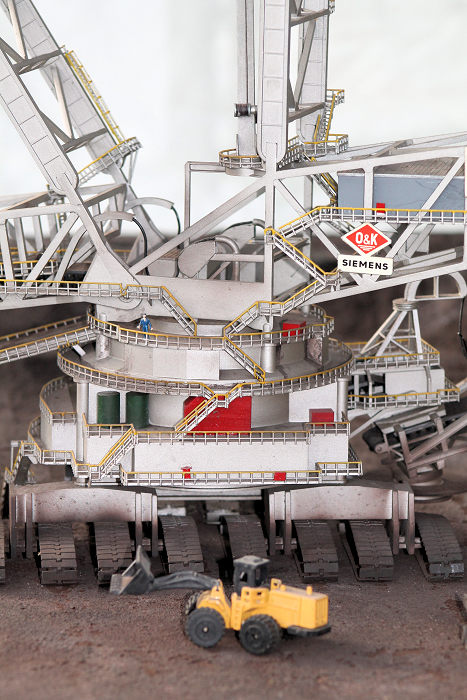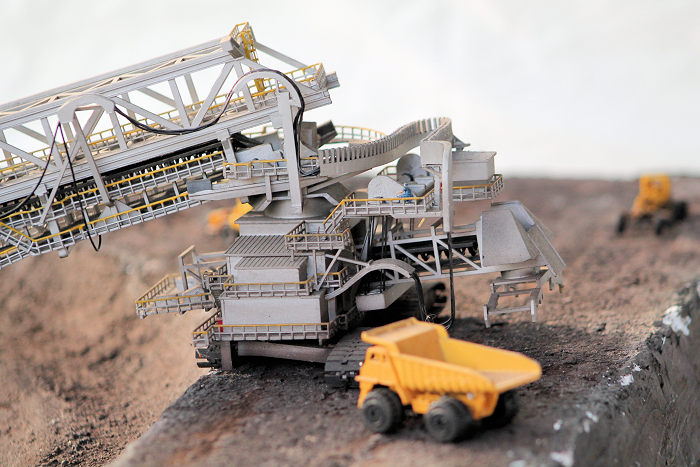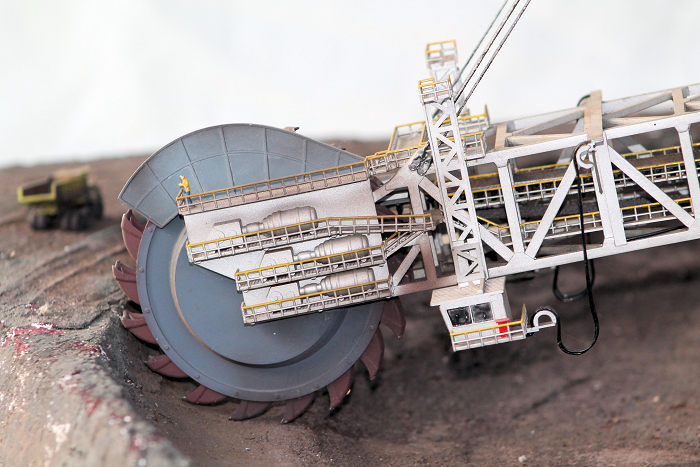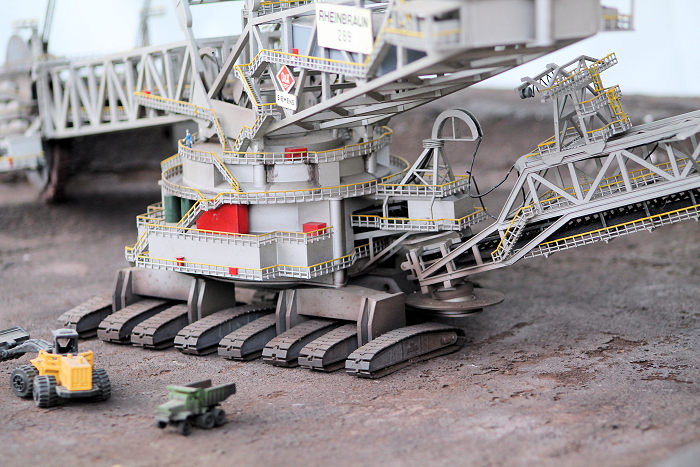
Revell 1/200 289 Bucket Wheel Excavator
| KIT #: | 05685 |
| PRICE: | $330.00 |
| DECALS: | Yes |
| REVIEWER: | Built by Harry Edmond, in Oz |
| NOTES: | 1984 tooling, 687 parts |

| HISTORY |
The Carboniferous Period extended from @ 360MYA
(million years ago) to @300MYA. It was a period when the land-masses were in
different places, and lots (and LOTS) of plants covered much of the Planet Earth
(a looooooong time before it was to become Man's). All of those plants were
absorbing lots (and LOTS) of the Sun’s energy and carbon dioxide from the
atmosphere, and replacing it with lots (and LOTS) of oxygen. But movement in the
underlying hot liquid magma (you may see it as volcanic lava) below the Earth
surface, caused the break-up, movement, and relocation of the land masses (aka,
continental drift). T his
in turn caused changes in the weather patterns, which affected the sea levels,
air temperature and shape of the land. This slow but remorseless
extinction-level event caused the lush Carboniferous rainforest ecosystem to
collapse. All of that dead vegetation became covered, and under pressure and
time, was changed into the hard black rock that we call coal (hence, it is
called a fossil fuel). The name of the period refers to the many coal beds
formed globally during that time. Eventually, we Humans evolved and discovered
that coal would burn. Burning coal reversed the process of the plants, and
released the Sun’s energy as heat and light, by taking oxygen out of the
atmosphere, and replacing it with carbon dioxide. Man found ways to harness the
released energy to manufacture items from other minerals & elements, and his
consumption of coal increased exponentially. Good thing that there is still a
lot of it, but most of it is still buried (to some degree).
his
in turn caused changes in the weather patterns, which affected the sea levels,
air temperature and shape of the land. This slow but remorseless
extinction-level event caused the lush Carboniferous rainforest ecosystem to
collapse. All of that dead vegetation became covered, and under pressure and
time, was changed into the hard black rock that we call coal (hence, it is
called a fossil fuel). The name of the period refers to the many coal beds
formed globally during that time. Eventually, we Humans evolved and discovered
that coal would burn. Burning coal reversed the process of the plants, and
released the Sun’s energy as heat and light, by taking oxygen out of the
atmosphere, and replacing it with carbon dioxide. Man found ways to harness the
released energy to manufacture items from other minerals & elements, and his
consumption of coal increased exponentially. Good thing that there is still a
lot of it, but most of it is still buried (to some degree).
At first, Man obtained coal by picking-up lumps that were on the surface of the ground. But soon He was using tools (picks & shovels, then machine-tools like jackhammers and drills) to extract it from below ground-level. All were made using the released Sun’s heat. Among the many impressive extraction machines Man has manufactured, is the Bucket wheel excavator (BWE). A bucket-wheel excavator (BWE) is a (very) large, heavy-mining machine used in surface mining. It supports a large wheel edged with buckets, each of which picks-up earth (= the over-burden) in succession as the wheel turns. The buckets empty the earth onto the machine’s integral conveyer belt, which carries it to there it is emptied into a fleet of correspondingly-large tip/dump trucks that transports to another area for sorting and processing. BWEs are among the largest land vehicles ever produced. The 14,200-ton Bagger 293 holds the Guinness’ World Record for the heaviest land-based machine ever built. Over 23 companies produce BWEs, which I find surprising. And they are used for strip-mining for all sorts on materiel hidden in the Earth, which I DON’T find surprising. I only wish that the mining companies would properly refurbish the land they mined. Remember, we, the current generation are borrowing the Earth from our children - we are not bequeathing it to them.
Amongst all of the kits produced (and re-popped) by
Revell, the most esoteric (IMHO) of them are the 1/200-scale off-shore North Sea
oil rig, Cormorant and the 1/200-scale 289 Bucket wheel excavator /
Schaufelradbagger. I would never purchase, or build, either one of them because
they lie outside of my scope
 of interest,
and where would I put such a large finished product? But I can say that I have
been privileged to see BOTH of then built to a very high standard, by two
extraordinary modellers here in Melbourne, Australia. Patrick built (and
illuminated and heavily enhanced) the oil rig (but THAT is another story). Harry
Edmond built the bucket wheel excavator.
of interest,
and where would I put such a large finished product? But I can say that I have
been privileged to see BOTH of then built to a very high standard, by two
extraordinary modellers here in Melbourne, Australia. Patrick built (and
illuminated and heavily enhanced) the oil rig (but THAT is another story). Harry
Edmond built the bucket wheel excavator.
Harry lived here in Melbourne, but miles away from me because Melbourne is a very spread-out place. He was a member of another Melbourne Modelling Club (we have near-on a dozen) with whom we came together for various modelling competitions and related activities (National or Local Competitions? Swap n’ Sell? Museum visit? Air show?). At these activities, the atmosphere is generally one of friendly rivalry and bantering (and eating). Harry was the personification of this attitude. Harry copped two big upheavals in his life. When he lost his beloved Wife, he was hurting inside and after he got caught in the fireball of a gas explosion, he was hurting on the outside, too. But Harry survived both and his attitude didn’t change.
But we lost Harry in April 2024. At the big June model show and competition (Model Expo) Harry’s Club put-on a tribute to him in the form of a display of some of his models, and awarded a one-off trophy (to the best Artillery piece – Harry’s favourite genera) in his memory. Unfortunately, Harry’s family elected to dispose of his completed models. So, I begged for this one, because (IMHO) it is unique, and one of Harry’s best.
| INFO ON THE KIT AND BUILDING THEREOF |
This link into Scalemates, shows what a complex kit it is. Schaufelradbagger 289, Revell 05685 (2020) (scalemates.com)
(from the box-top – which is a photo of the real thing) there are 687 parts, and the model spans over a metre (note the 300mm / 12” tape measure in one shot). Included are two diameters of thread and a rubber strip to replicate the conveyor belt. Another modeller might want to build it in a ‘Showroom’ condition by (say) painting more parts (safety railings etc?) in a less-weathered yellow or day-glow red.
 Construction,
Painting and Decaling.
Construction,
Painting and Decaling.
I have no information on Harry’s build, but it looks like he built it OOB. I thought that I was good because I rigged a 72-scale D.H. 2, but Harry’s rigging of this monstrosity is generation ahead of my efforts. You will note that the arm that carries the extracted material up to the waiting trucks, is articulated. This makes carrying the model potential problematic, but the rigidity of the properly-glued rest of the model goes a long way to allowing it to be moved in one piece. But I will let the photos do all of the talking.
Finalisation.
Harry elected to display his BWE in an operating mode, though without adding the clouds of dust that would be produced (and impossible to model). This required a large (1060 x 900mm) base - that is 300mm/12" of tape-measure in one of the photos. He also sought-out suitable small-scale vehicles to show what a behemoth this machine really is. Unfortunately, they are in different scales, but they get the impression across.
| CONCLUSIONS |
 As well as
being a terrific modeller, Harry was a brave modeller. Building this proves it.
There were two other brave people in the production of this model – the one who
approached Revell and said “Let us produce a kit, in small scale, of a huge
mining dredge.”, and the other who said “Yes – start cutting the moulds. We’ll
sell thousands of them.”
As well as
being a terrific modeller, Harry was a brave modeller. Building this proves it.
There were two other brave people in the production of this model – the one who
approached Revell and said “Let us produce a kit, in small scale, of a huge
mining dredge.”, and the other who said “Yes – start cutting the moulds. We’ll
sell thousands of them.”
Harry was my friend. He taught me (and others) that you don’t need an ego to be a good modeller. In fact, without an ego, other modellers will see you as a better modeller that you might be (I’m still working on this ‘being a better modeller’ bit). RIP, Harry.
Article and images by George Oh
6 August 2024
Copyright ModelingMadness.com. All rights reserved.
No reproduction in part or in whole without express permission. If you would like your product reviewed fairly and fairly quickly, please
contact
the editor or see other details in the
Note to
Contributors.